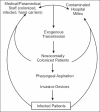Nosocomial pneumonia in critically ill patients
- PMID: 20931034
- PMCID: PMC2946717
- DOI: 10.4103/0970-2113.68321
Nosocomial pneumonia in critically ill patients
Abstract
The care of critically ill patients in the intensive care unit (ICU) is a primary component of modern medicine. ICUs create potential for recovery in patients who otherwise may not have survived. However, they may suffer from problems associated with of nosocomial infections. Nosocomial infections are those which manifest in patients 48 hours after admission to hospital. Nosocomial infections are directly related to diagnostic, interventional or therapeutic procedures a patient undergoes in hospital, and are also influenced by the bacteriological flora prevailing within a particular unit or hospital. Urinary tract infections are the most frequent nosocomial infection, accounting for more than 40% of all nosocomial infections. Critical care units increasingly use high technology medicine for patient care, hemodynamic monitoring, ventilator support, hemodialysis, parenteral nutrition, and a large battery of powerful drugs, particularly antibiotics to counter infection. It is indeed a paradox that the use of high-tech medicine has brought in its wake the dangerous and all too frequent complication of nosocomial infections.
Keywords: Hospital acquired pneumonia; nosocomial pneumonia; ventilator associated pneumonia.
Conflict of interest statement
Figures
References
-
- Jarvis WR, Edward JR, Culver DH. Nosocomial Infection rates in ICUs in the United States: National Nosocomial Infection Surveillance System. Am J Med Br. 1991;91:1855–15. - PubMed
-
- Vincent JL. Nosocomial Pneumonia. Indian J Crit Care Med. 2001;5:148–56.
-
- Verdeil X, Bossary JP, Roche R, Barret A, Pouns J. Nosocomial infection surveillance in a vascular surgery unit. Am Vasc Surg. 1990;4:553–7. - PubMed
-
- This official statement of the American thoracic society was adoptedby the ATS board of directors, American Thoracic Society. Hospitalacquired pneumonia in adults: Diagnosis, assessment of severity, initial antimicrobial therapy, and preventive strategies. A consensus statement. Am J Respir Crit Care Med. 1995;153:1711–25. - PubMed
-
- Fleming CA, Balaguera HU, Craven DE. Risk factors for nosocomial pneumonia: Focus on Prophylaxis. Med Clin North Am. 2001;85(6):1545–63. - PubMed
LinkOut - more resources
Full Text Sources


